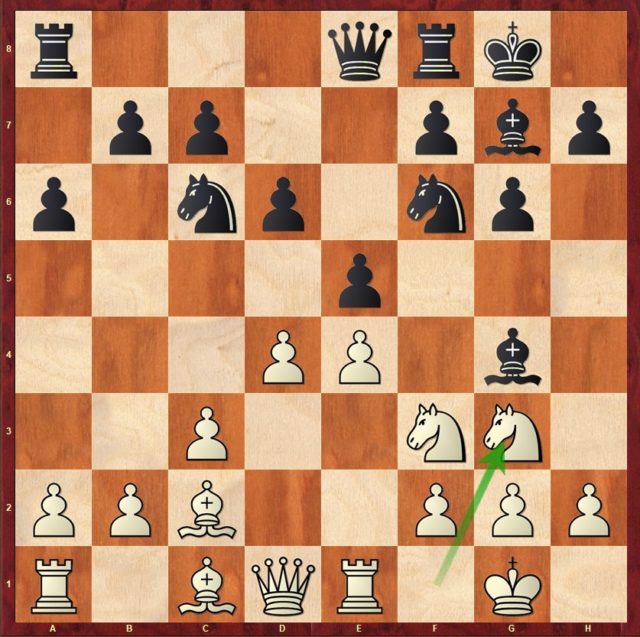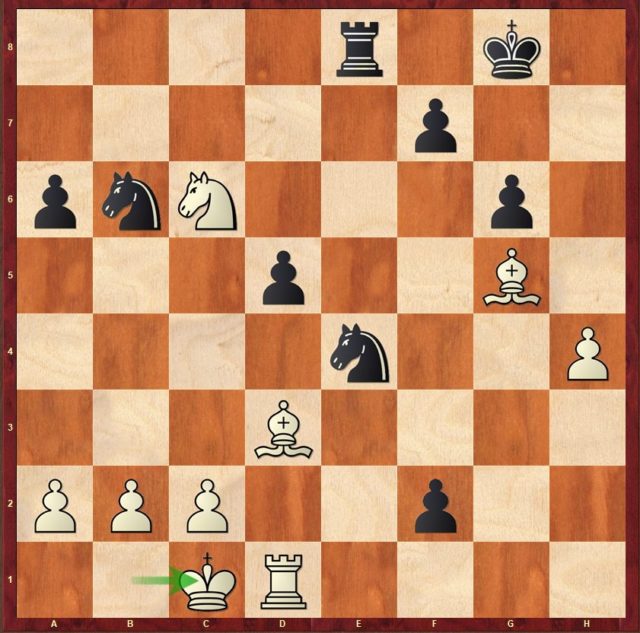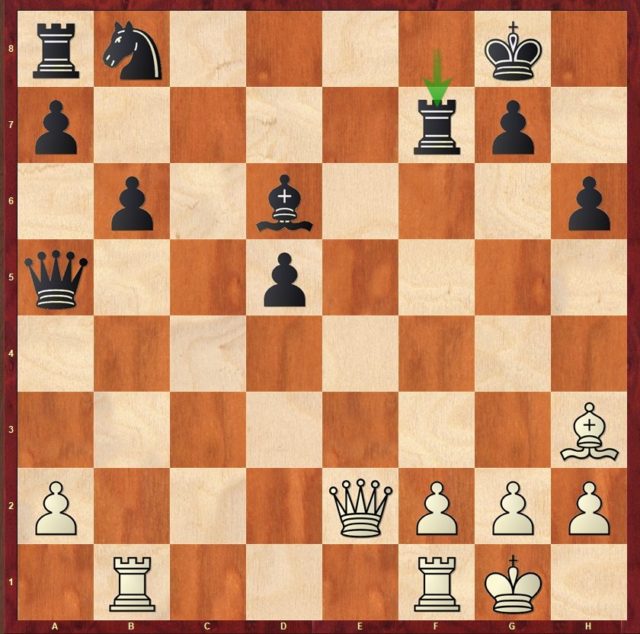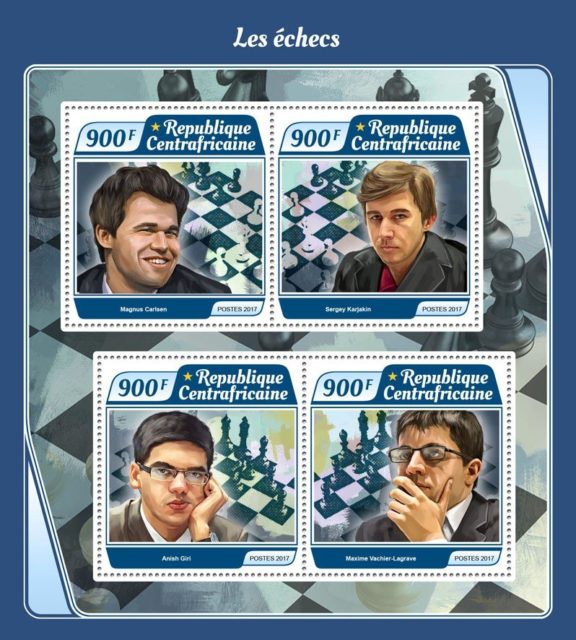In October, I spent a lot of time in London, where I played in two consecutive tournaments…
Global Chess League
This was the second season of this 6-player team tournament organized by the Indian company Tech Mahindra. Our Mumba Masters team missed Alexander Grischuk, who was unable to obtain a visa; he was replaced by Peter Svidler. We also had a change on the Prodigy Board, with the arrival of Raunak Sadhwani. On the whole, there was a good atmosphere. These team matches are always fun, with lots of convivial moments, blitz, ping-pong sessions etc. But unfortunately we lost a lot of tense matches at the start of the competition. As a result, we were quickly eliminated from the race for the top 2 qualifying places for the Grand Final, and had no choice but to save our honor. The rhythm of play was 20+0, which is a bit weird, but increment-free is clearly coming back into fashion! On a personal note, I achieved a score of 5/10 on the Icon Board against Carlsen, Anand, Giri, Firouzja and Nakamura, each of whom I met twice.

Of course, I’m pleased with my 1.5-0.5 victories over the first three, in games that were rather well controlled; but a little less satisfied with my defeat to Naka, and especially with the 0-2 that Alireza inflicted on me… Indeed, it’s never pleasant to suffer two losses in positions that could easily have led to victories! It’s the difference between a decent result and a good one… From the team’s point of view, my two losses against Alireza led to match defeats, and that meant a lot in the race for the play-offs. But I also won the team some other matches 😊.
WR Chess Masters
Two tube stations further, back to classical chess at the Langham Hotel, a beautiful London palace with an excellent French restaurant run by Michel Roux, the Palm Court. It’s worth noting that Alireza, never stingy with surprises, knew it from the Netflix series « Five Star Chef », which takes place precisely at the Palm Court!

The tournament itself had an original format, which I certainly enjoyed, but was nonetheless very difficult (1h/30, 30’/20 + 30’ko). Cup format, two potentially 4-hour games per day, and a possible tie-break late in the evening! A game at 10am (that’s really early), the return match at 5pm, and the tie-break at 10pm, makes for some busy days! With games lasting up to 3 hours, we could easily start at 11am, or even noon. But 4 hours is the FIDE minimum for a classical game to be rated (for those of you wondering why we had to play at such an odd pace without increment). We had a few technical discussions beforehand, as there were quite a few issues to be addressed due to the lack of increment, notably how to deal with players flying pieces in zeitnot… I also suggested that, in those forthcoming 16-player knockout tournaments, there shouldn’t be 16 seeds, with the whole bracket determined from A to Z, but 4 seeds and a draw, as is done in tennis.
Time to play! I started the round of 16 against Sindarov, the lowest-rated player I’d played in the tournament, but who gave me a lot of trouble throughout the match (including the Armageddon!). It was a heck of a struggle. I knew it was going to be a tough match, because he is the player who knocked me out of the 2023 World Cup and who’s capable of performing at a very high level. I’m pretty pleased to have escaped unscathed!
After that, I finished my Uzbek championship against Abdusattorov 😊. In fact, I’ve played 5 games in a row against Uzbeks (including the last game of the Olympiad), and even 7 if you ake into account the first 2 Armageddon games of this tournament! I did a little better in this match, even if with black, I found myself in a bit of difficulty. But I managed to solve it like the Grünfeld acrobat that I am 😊. Let’s go straight on to the Armageddon, which was the occasion for me to play a nice game.

12…Nh5 is logical insofar as 12…exd4 13.cxd4 Bxf3?! 14.gxf3 was inferior, but also because if 13.Be3, there would now be 13…Bxf3 14.gxf3 Nf4 which is no good for white (since there was no exchange on d4). So I had to close the center with 13.d5, but took an edge after 13…Ne7 14.h3 Bxf3 15.Qxf3 Nxg3 16.fxg3! a typical move in this kind of position, and one that’s nice to show my dear readers 😊.
I was gradually able to improve my position, especially after 16…f5 17.g4 fxe4?! (17…fxg4 was stronger, but it wasn’t easy to see) 18.Qxe4 Kh8 19.Be3, as the Ne7 found itself really dominated in the position. After 19…c6 20.Bb3 (20.c4! was more accurate), I thought he absolutely had to take on d5, and after 20…cxd5 21.Bxd5 Nxd5 22.Qxd5, try to equalize with 22…Qb5!. 20…c5? was a strategic error, after which black is suffering. I thought I was playing on the Queenside, as you always do in these structures, but in fact I have a big advantage on the Kingside, which is paradoxical.
There was a very strong plan, which I didn’t see, to put my pawns on h4, g5 and g4, then continue with Kg2, Rh1, h5 and Bc2 and I’m the attacker on the Kingside!

Here, I’ve kept my Queenside advantage, but there’s a move that’s very difficult to find. You have to understand that black threatens 37…h5! – to incite an en passant capture and revive its Bg7 – much more than 37…Rf4; hence 37.Bd2! with complete domination, e.g. 37…Qf2 38.Qe1!. But both Nodirbek and myself only anticipated 37.Rxb7? Rf4? while 37…h5! equalized, admittedly somewhat miraculously. White has a multitude of ways to continue attacking, but none of them is satisfactory. 38.Be6? Ne2! would really not be a good idea. 38.Qxg6 Qf4+ only gives the perpetual. 38.gxh6 Bxh6 gives access to the f4 square, and black doesn’t care about 39.Bxd4 exd4 40.Qxd4+ Rf6!. Finally, 38.Bxd4 exd4 (38…hxg4? 39.Bg1!) 39.Be2 looks strong since if 39…Be5+? 40.Dxe5; but black still has the resource 39…Qc1!, and with the threats …Be5+ or …Qxg5, the position remains very uncertain.
In the game, I concluded with 38.Rb8+ Bf8 39.Qe1 (I’d also seen the simpler 39.Rxf8+ Rxf8 40.Bxd4) 39…Qd3 40.b5! and black is caught out all over the board. In the end, it’s the whole concept that with pawns on d5 and g5, black’s position is completely paralyzed throughout the game.

In the semi-final the following day, I was up against my compatriot Alireza (Firouzja). The first game, a Sicilian Alapine, turned out to be quite tricky, especially when I started to lose control of the position… But as we were running out of time, we were naturally led, as is often the case in this kind of situation, to variations in which all the pieces were exchanged. The game with black went well, thanks to a very good preparation that dried out the position.
On the other hand, my third Armageddon went totally out of control; it must be said that I didn’t expect Alireza to go after me in such a huge variation of the Najdorf!

I knew I wasn’t playing my preparation exactly, but I was fairly familiar with this line where white sacrifices the d5 pawn. Here, I thought 19.Bxf6 Bxf6 20.gxh5 e4? (better is 20…Nc4) 21.fxe4 Qe5 was strong, but in fact it’s very bad because there’s 22.c3 Qxh5 23.Qf2 Nd7 24.Rh1. But he played 19.Qh2, the move I was expecting, after a very long thought. It’s « badly played » on his part, because these are positions where I’ll be able to play moves instinctively and he much less so. I played 19…Rae8?! a little too quickly because I missed
20.Qxe5 Qxe5 21.Rxe5 and if 21…hxg4? 22.Rxe7!. As a result, I was forced to play 21…Bd8
but now he has 22.Rxe8 Rxe8 23.Nc5 hxg4 24.Nxb7 and I had the choice between suffering martyrdom with 24…Be7 or giving the piece away and trying to fish in troubled waters with 24…gxf3!? 25.Nxd8 Ne4. Obviously, true to form I made the second choice, with a lonely onslaught of my f2-pawn after 26.Nc6 f2. He took quite a lot of time as everything looks winning for white, but nothing is really completely clear, which is the advantage of this kind of position. Personally, I thought the cleanest move would have been 27.Be3, but his 27.Kc1 seems logical.

But then, as I knew he was threatening 28.Be3, I played 27…Ng3. There’s 28.Ne7+ Kg7 29.Be3 which is enough here; these are fairly simple variations, but there are so many options… He played 28.b3 and suddenly it’s a little less clear, although after 28…Re1 29.Bf4 Nf5, the simplest win was 30.Kd2 Nxh4 31.Nd4. After 30.Bd2 Rg1 there was still 31.Ne7+! Nxe7 32.Be3, but now it becomes hard to find! He played the more natural 31.Rf1 with a similar idea (if 31…Ng3 32.Be3! Nxf1 33.Bxf2!). So I replied 31…d4. There, 32.Nxd4 was still strong, and if 32…Ng3 33.Rd1. But he chose 32.Kb2 Ne3 33.Bxe3 dxe3 34.Bxa6 Nd5 35.Nd4 Nf4, which is still winning but the position gets very tricky, especially as he was starting to run out of time. After 36.c3 Nh5, he finally blundered with 37.b4?? Ng3 38.Rc1 Rxc1 and 0-1 as black’s pawn queens after 39.Kxc1 e2!. However, despite the many inaccuracies, white would have kept a winning endgame had he played 37.Nc2! Ng3 38.Nxe3 Nxf1 39.Nxf1. A big turnaround, as sometimes happens in this kind of Najdorf 😊.
Then, the final against Erigaisi, who was, and still is, in dazzling form, tickling the 2800 Elo mark. Once again, I started with white. It’s true that I perhaps didn’t reach the full potential of the positions I got in my white games, but these were all morning games 😊. What’s more, you have to be super careful because a loss is almost the same as an elimination; indeed, the only person to come back from a defeat with white was Abdusattorov against Kosteniuk in the first round, and it’s fair to say that this upset wasn’t really expected.
Against Erigaisi, I was probably a little too solid with white, but with black it went rather well. In the 6.Be2 Najdorf, I was familiar with the somewhat atypical sub-variation 6…e5 7.Nb3 Be7 8.h4 Be6 9.f4!?. I figured there were quite a few moves that had to be ok, but I wanted to try a line against which he would be less prepared, hence 9…g6!?. The debate became very tense immediately!

Here the best was 15.Bxb7! after which there were two possible continuations; first 15…Ra7 16.Bf3 Qxd6, which to me seemed the best, but the machine shows us that 17.Bh6! is very strong. The alternative 15…Bc4+ 16.Kg1 Bxb3 also gives white the advantage after 17.Ne4! (but not 17.axb3?? Qc5+), though it’s far from obvious at first sight. Erigaisi preferred
15.Ne4 Nc6 16.Nxg3 Qxg3 17.Bxc6 (there’s still 17.Be3!, but it’s too hard) 17…bxc6 18.Qd4
(the logical continuation) 18…f6. Just after playing this move, I realized that the spectacular 18…Bd5! might have been playable! The more I looked at the lines, the more I thought it would have been interesting since 19.Qxh8+? Nf8 didn’t work because of the double threat of …Bc4# and …Qxg2+. But my regrets were limited as I quickly understood that 19.Qe3+ was possible and that I wouldn’t have been better after the Queens exchange. After
19.Bf4 Qg4, I looked carefully at 20.Nc5. At first, I wanted 19…Bd5?!, but it’s actually not very good because of 20.Qe3+ Ne5 21.Qg3!, and the Nc5/Pd6 construction is overpowering. 19…0-0 is the safe little move I probably would have played. But he ended up playing 20.Bd2, which seemed a bit odd, I must say. After 20…Ne5, I was looking at 21.Rh4 which is the best move, but he probably didn’t want 21…Bc4+ 22.Kf2 Qe2+ 23.Kg1 Bd5, and played
21.Qxg4 Bxg4 22.Ba5. I’d seen this in advance, with the transfer of the Bishop to c7 to support the d6 pawn. If he gets the Bishop on c7 and my Rook remains on a8, it can get a bit unpleasant, hence the immediate 22…Rb8!. I thought it was starting to look good for me with the Rook coming to b5, the Nb3 being a bit dominated, and not too many possibilities to play c4…

After the exchange sacrifice 30…Rxb3! 31.cxb3 Bd5! I figured it was going to be very difficult for him, but the computer is laughing 😊. And our future +2800 club member found the moves! 32.Rd4 is the easiest as it prevents 32…Nf3+ because of 33.Rxf3 Bxf3 34.Rf4 and 35.Rxf6. 32…g5 33.Rf1 Rh1+ 34.Ke2 Rh2+ 35.Kd1. Now, if 35…Rxb2, there’s 36.Rb4, or even 36.Rh3, hence 35…Bf3+ 36.Kc1 c5. Beforehand, I thought I’d be much better here, but I realized as I went along the lines that 37.Rc4! was possible (37.Rd2? Rh1+ 38.Kc2 g4! is losing). So we agreed upon a draw after 37…Nxc4 38.bxc4 Bg4. A fighting draw where we both felt we had a chance, but especially me in fact! Strangely enough, we didn’t miss a thing, it was a game of high quality.

So all that remained was a final Armageddon game to decide who would clinch the tournament…
I had no idea what he was going to play exactly, but I didn’t think it would be the Petroff! I did have an idea in the variation he chose though, except I handled it badly.

I played 22.Be6? too quickly. I should have started with 22.Rb5 Qa3 23.Rxd5, because after 22…Nc6, if 23.Rb5? now there’s 23…Nd4 24.Bxf7+ Kf8! (the move I missed). During the game, I thought that 24…Kh8? was winning for black, but no! 25.Qe8+! Rxe8 26.Rxa5 +-. So I was forced to take on f7, and after 23.Bxf7+ Kxf7, to play 24.Rb5. And now, admittedly there’s only one move for black, but it’s not very hard to find as you have to protect the Nc6, so it’s 24…Qc3. After 25.Qh5+ Kf8 26.Rxd5 Rd8 27.Rfd1 Ne7, black has two pieces for the Rook, has consolidated his position and my attack is moribund. I noticed when I played 28.Rb5? that 28.R5d2 would have set the trap 28…Bxh2+? 29.Qxh2 Rxd2 30.Qf4+. But I saw it half a second too late, even though I’d taken quite a bit of time on this move; in fact, 12 seconds, which in Armageddon is an eternity 😊.
I still managed to find resources later in the game.

I started to regain confidence here, because if 35…Nd4? 36.Qe8+ Kh7 37.Rf8 Qc1+ 38.Kg2 Qc6+ 39.Qxc6 Nxc6 40.Rc8 wins. I felt he saw it in time, panicked and came back with 35…Ne7. Bad news for him, the position is equal again, good news it’s « only » equal and I’m obliged to win with white! 36.Rf8+ Kh7 37.Qe4+ Ng6 38.Re8 Be5 39.Re6 Bf6 40.h4 Qd4 41.Qf5 Qc5. But I didn’t see my last possibility to try something by playing 42.Qxc5 bxc5 43.Ra6, even though I’m not very optimistic about my objective chances in this endgame. But with less than 2 minutes on the clock, it wouldn’t have been so easy in practice for black.
In the game, I tried to force events by keeping the Queens on with 42.Qb1, but I even ended up losing this game!
Congratulations to Arjun Erigaisi on his final victory in the tournament, which follows on from his Olympic title with India; based on what he’s produced over the past year, he deserves these awards!
Maxime’s games in the Global Chess League:
Maxime’s games in the WR Chess Master:
For all chess players who, like a certain A Karpov, have a soft spot for philately, there are 10 stamps bearing the effigy of Maxime, all issued between 2012 and 2019, and all from African countries!
From Togo to the Maldives, from Guinea-Bissau to the Central African Republic, from Niger to Guinea, all the way to the small island of Sao Tomé-et-Principe, you’ll find special Chess issues as part of collections on sport or other more original themes in which the Royal game is included.


